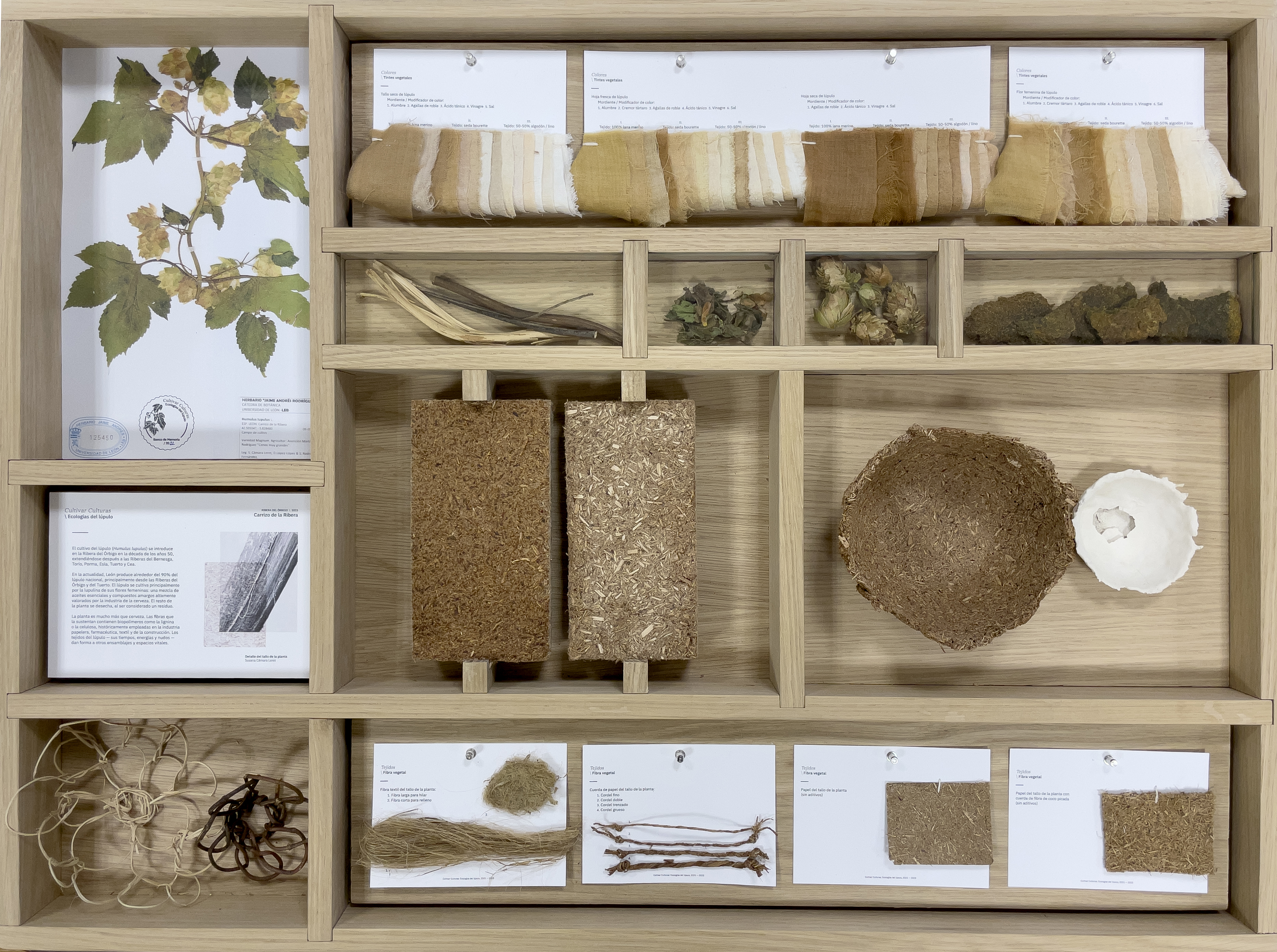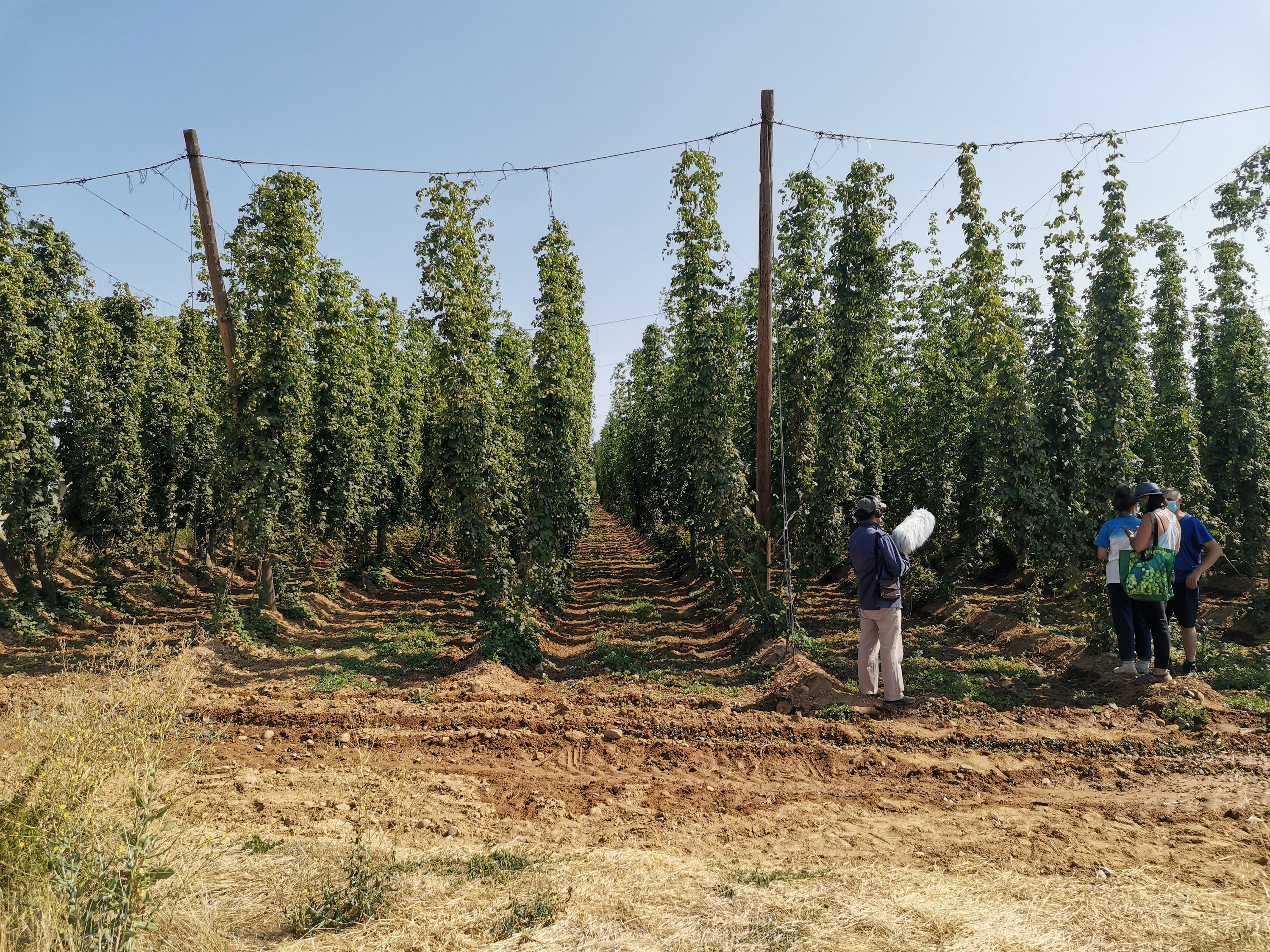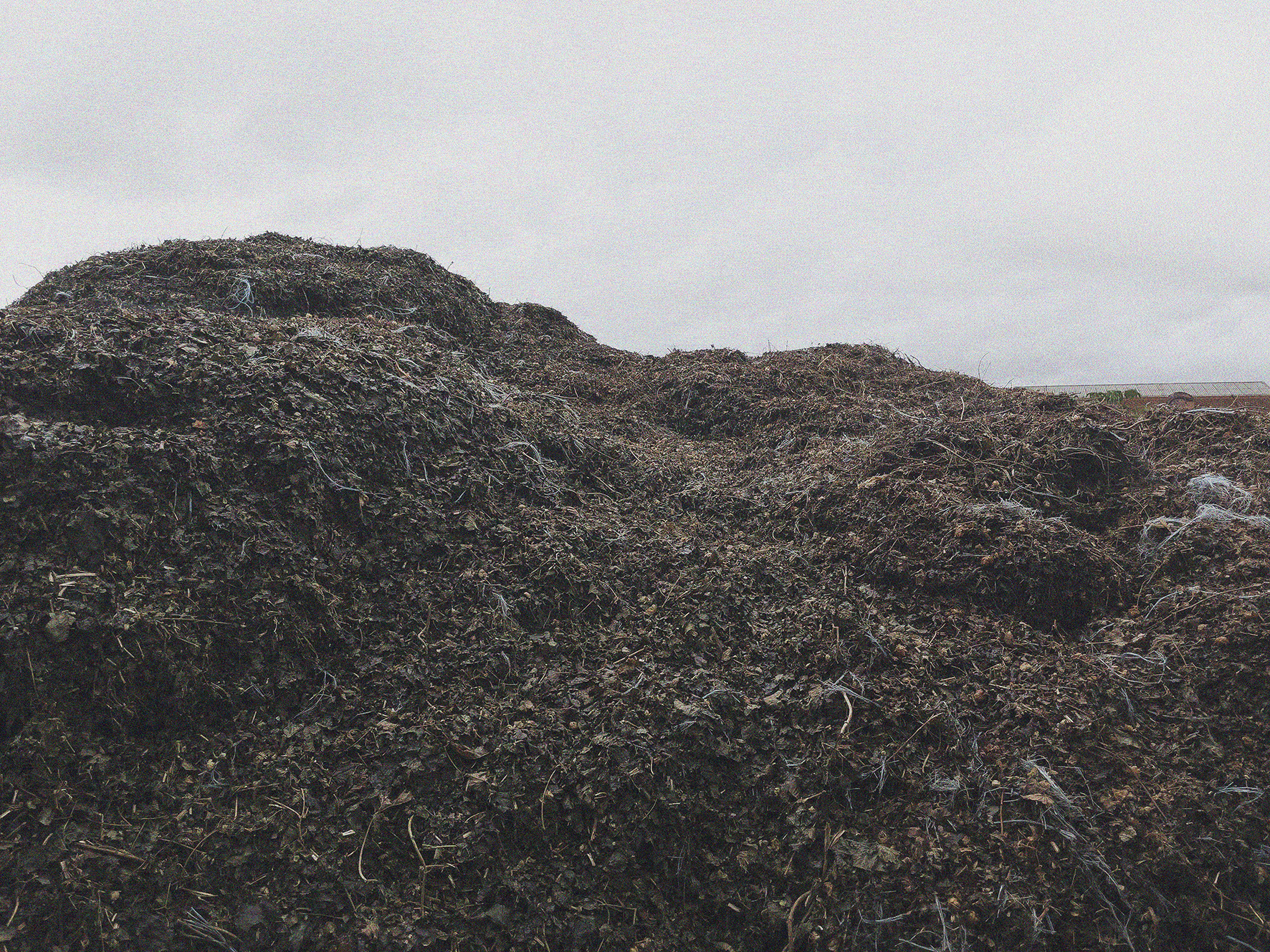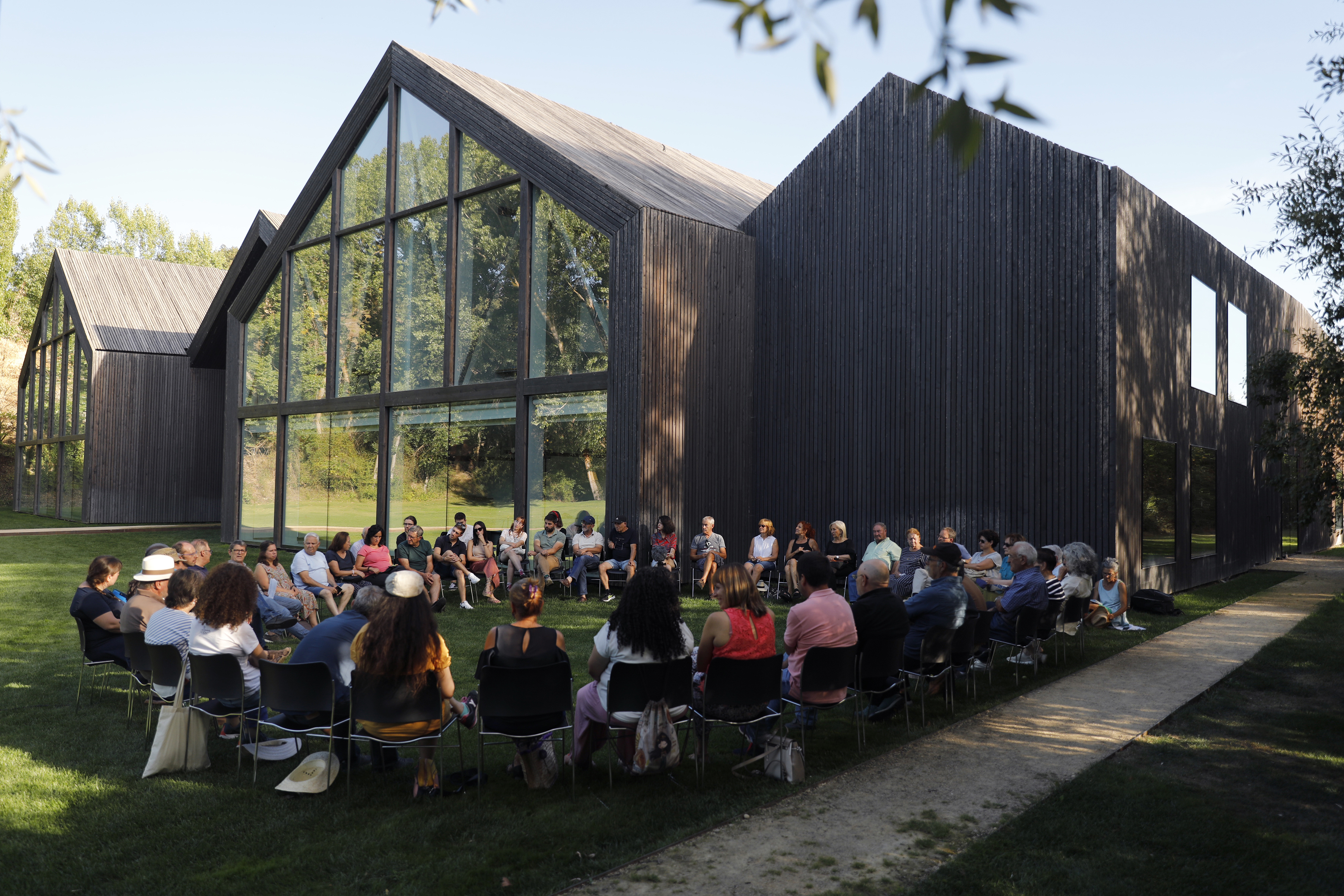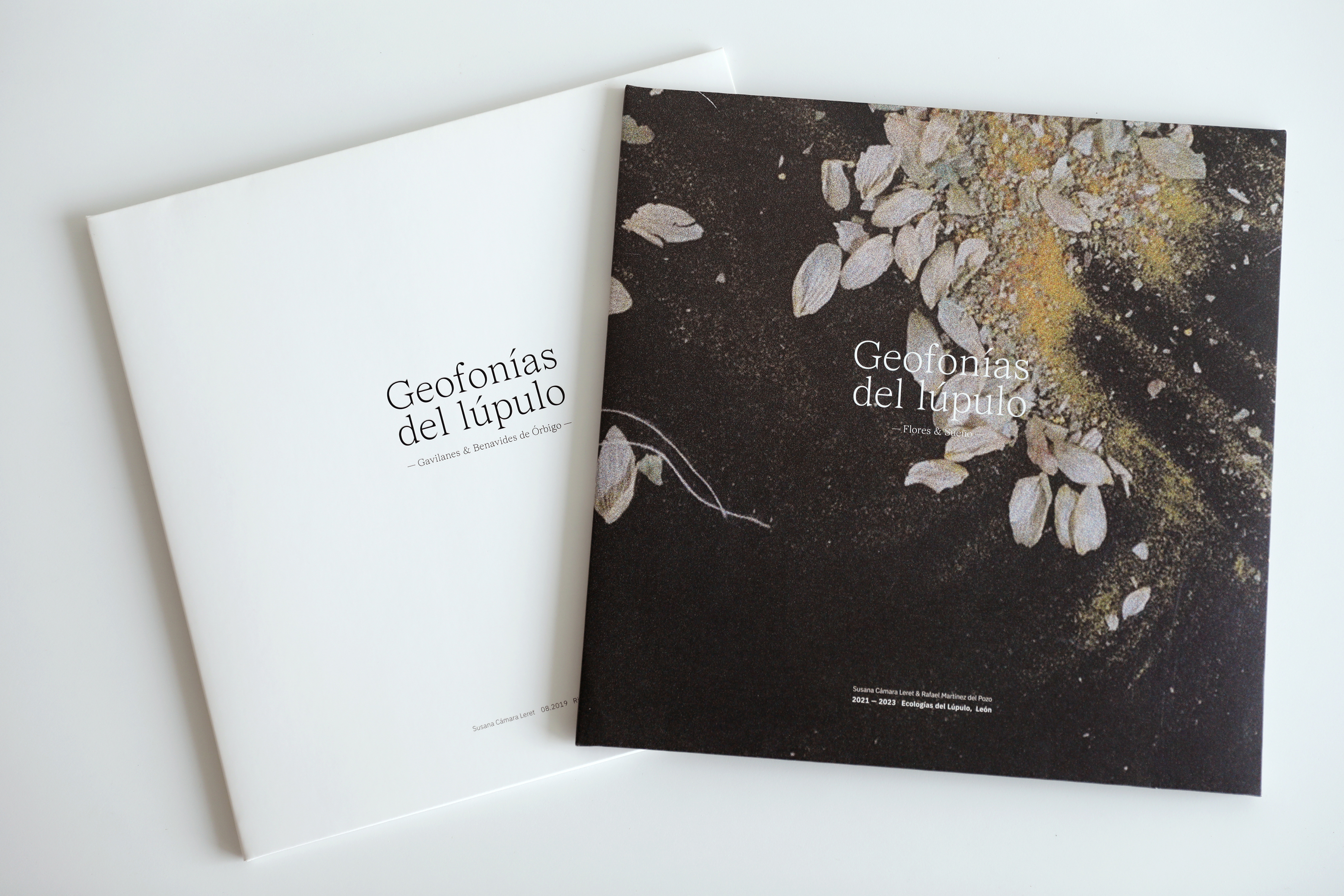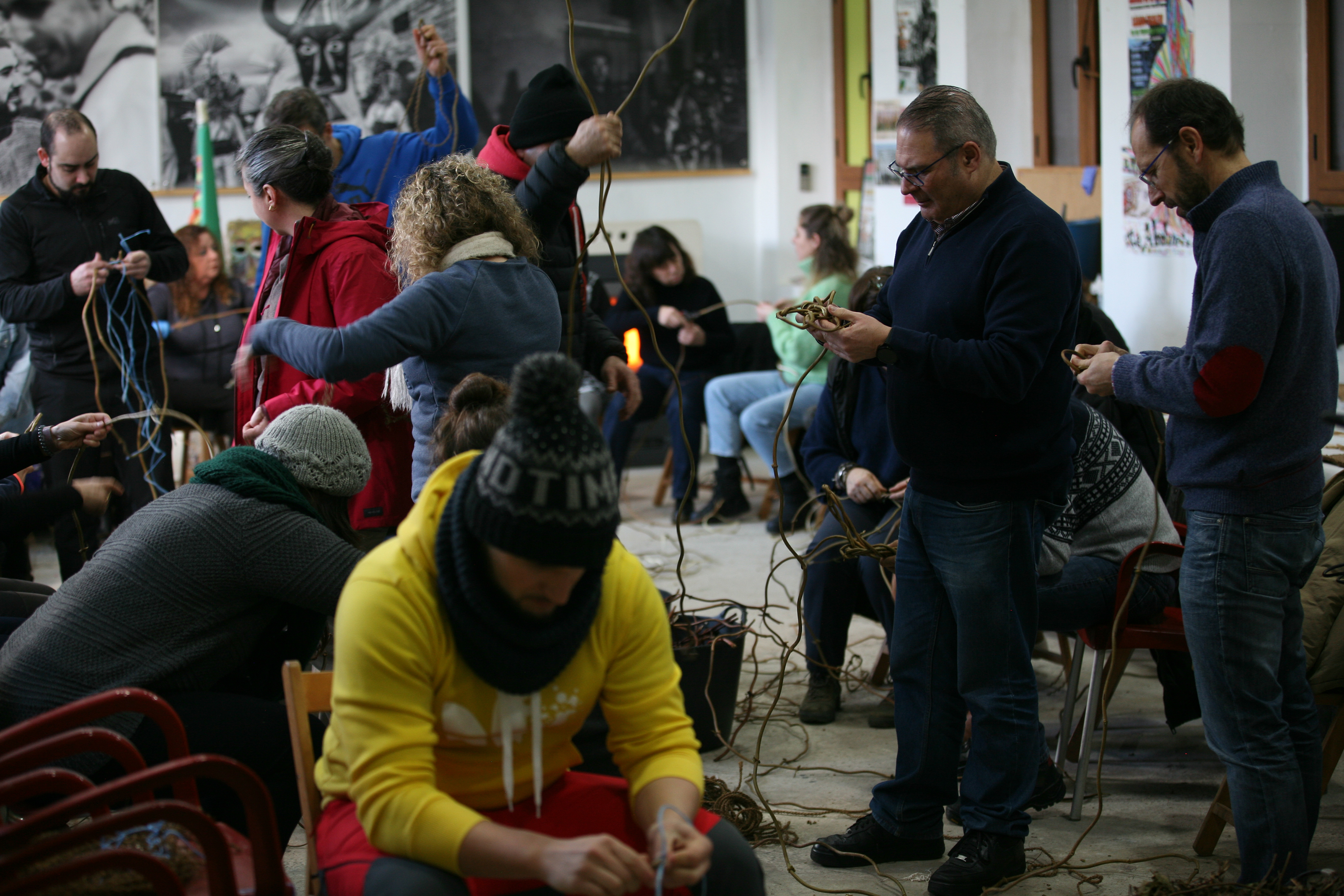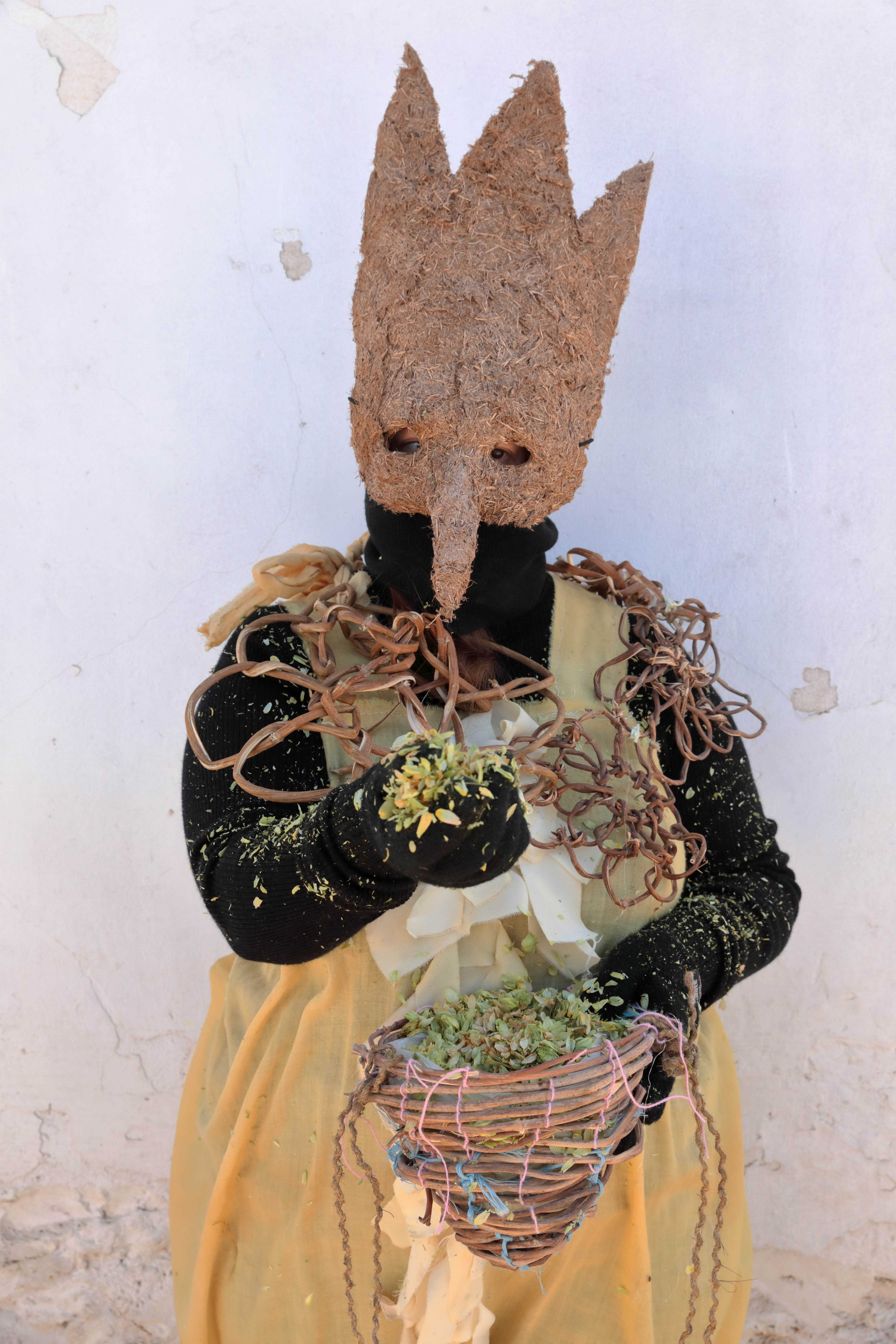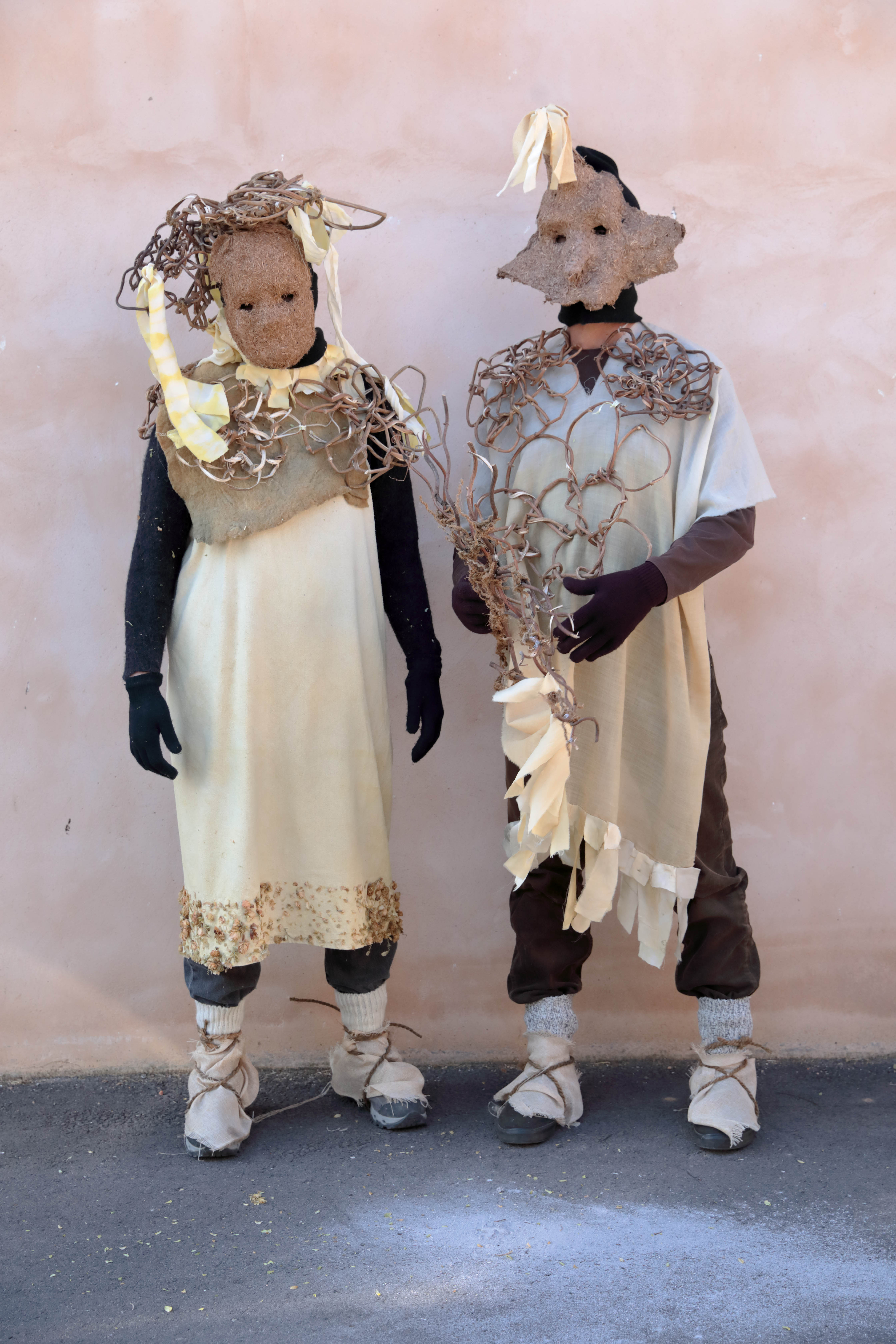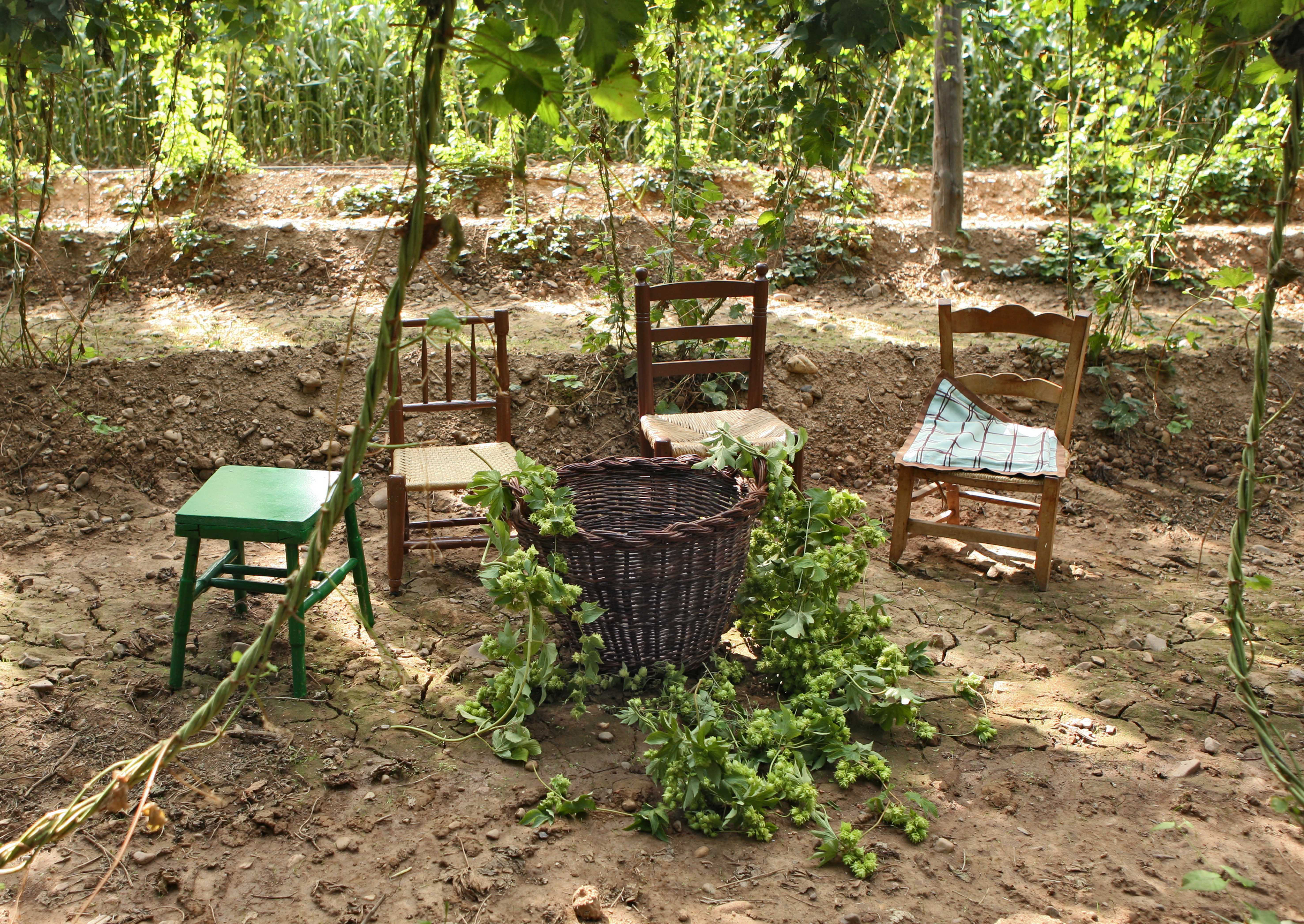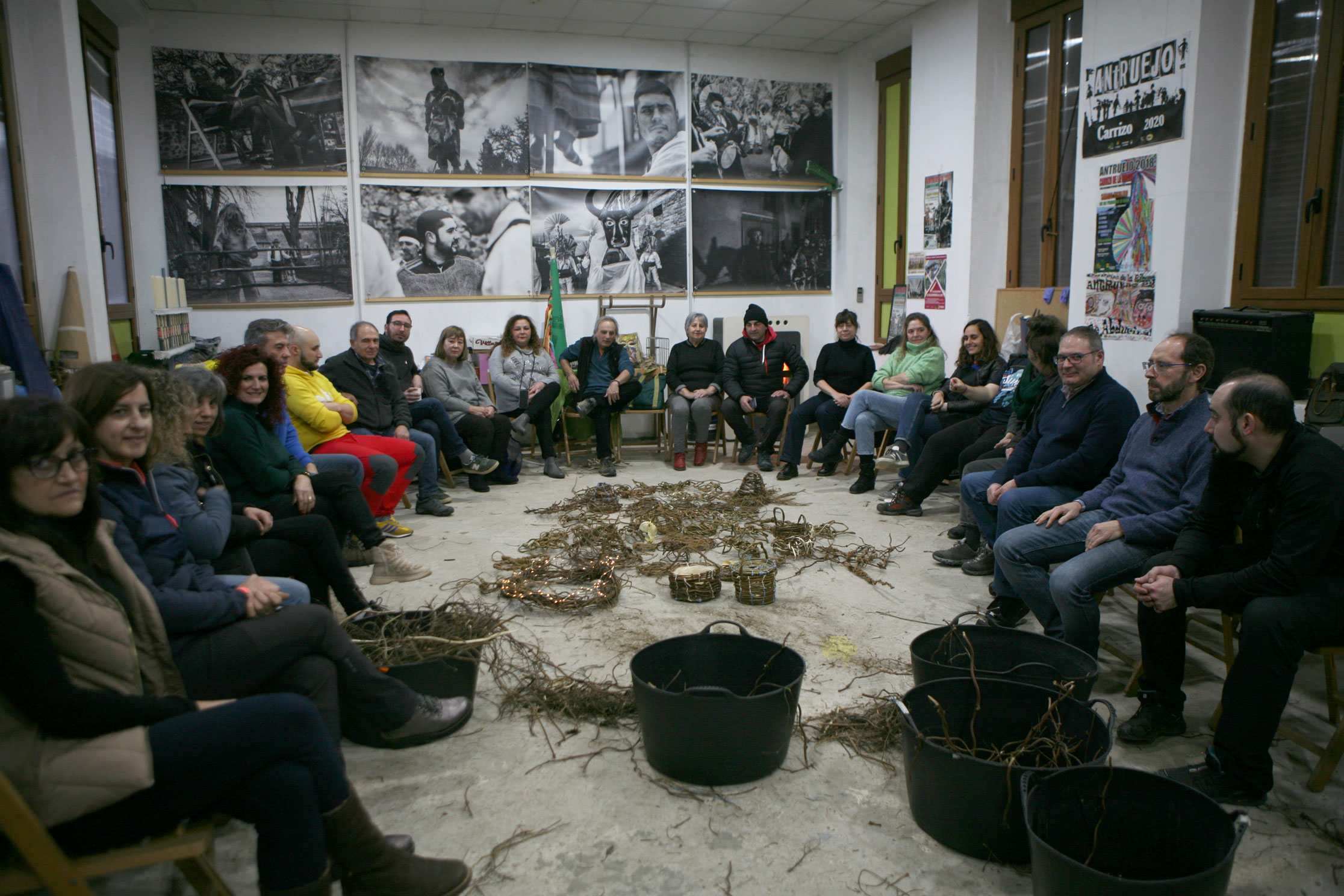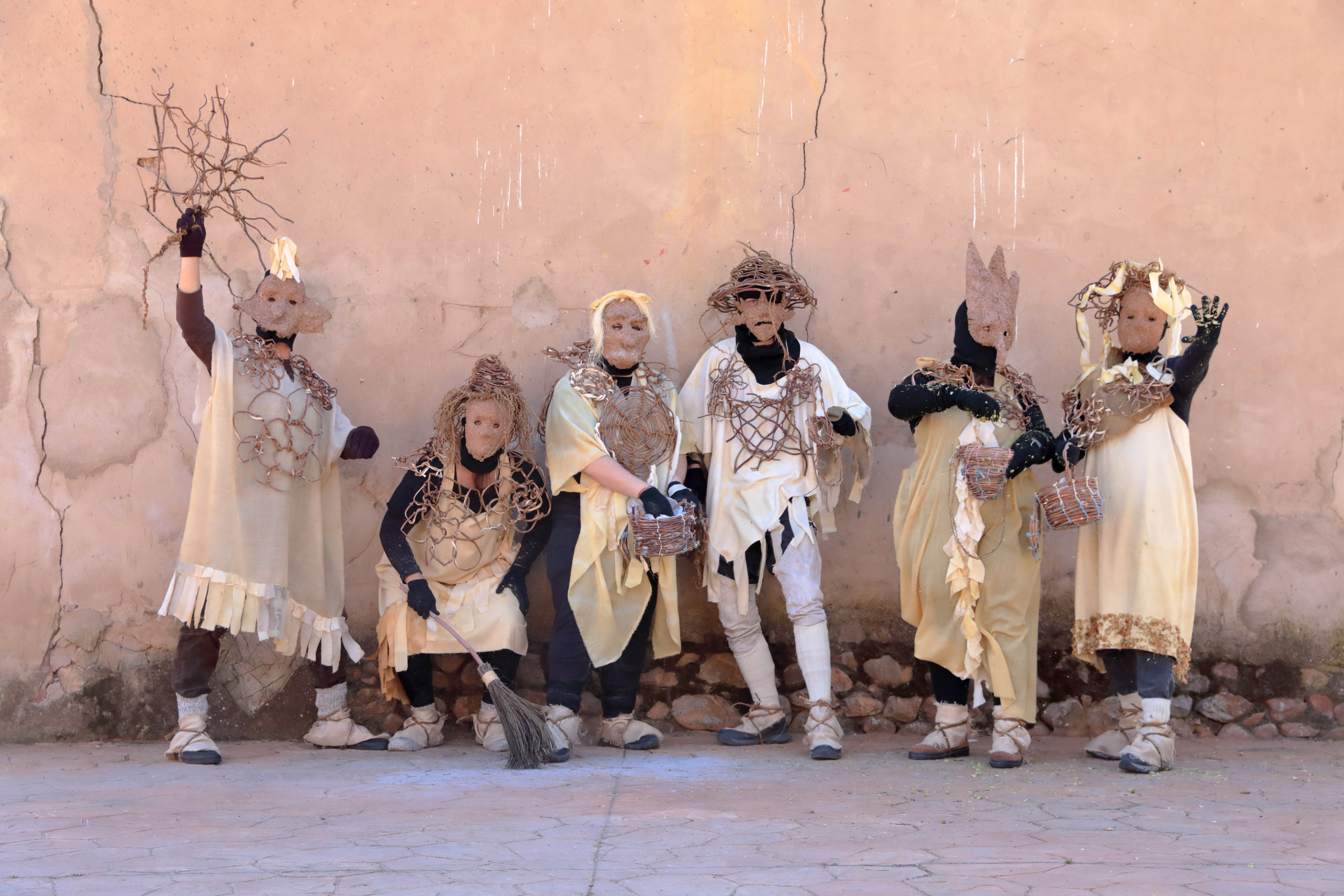Reconnecting with nature
Ecologies of Hops
Cultivate Cultures: Ecologies of Hops
Ecologies of Hops promotes sustainable, rural livelihoods and imaginaries amongst hop harvesting communities. The province of León produces 95% of Spanish hops and is threatened by corporate agriculture which creates large amounts of waste. Under the premise that hop is more than beer, the project applies circular, biofabrication methods to promote a more regenerative agriculture and help rebuild connections to local agrarian traditions, landscapes and knowledge.
Spain
Regional
The project was hosted at the village of Carrizo de la Ribera (León, Spain). Its activities developed across the following riverbanks and rural villages linked to hop cultivation, of less than 2.000 inhabitants each:
• Órbigo riverbank: Villoria del Órbigo, La Milla del Río, Villarejo de Órbigo, Gavilanes de Órbigo, Benavides
• Tuerto riverbank: San Román De la Vega, San Justo De la Vega
• Porma riverbank: Cerezales del Condado, Vegas del Condado
• Esla riverbank: Villanueva de las Manzanas, Mansilla de las Mulas.
• Órbigo riverbank: Villoria del Órbigo, La Milla del Río, Villarejo de Órbigo, Gavilanes de Órbigo, Benavides
• Tuerto riverbank: San Román De la Vega, San Justo De la Vega
• Porma riverbank: Cerezales del Condado, Vegas del Condado
• Esla riverbank: Villanueva de las Manzanas, Mansilla de las Mulas.
Mainly rural
It refers to a physical transformation of the built environment (hard investment)
Yes
2023-12-31
No
No
No
As an individual
Ecologies of Hops is an art-led, multidisciplinary project concerning the politics, aesthetics and modes of consumption of hops in the province of León, which produces 95% of all Spanish hops.
The research begins in 2019, through the work of artist, designer and researcher Susana Cámara Leret. Between 2021-2024, it formalises a multidisciplinary platform for research, experimentation and participation involving hop communities, biologists, anthropologists, chemists, artists and artisans.
Hop is harvested for its flowers’ lupulin, an essential ingredient in beer popularly known as “wealth” due to its economic relevance. The ca.100.000 tonnes of hops produced yearly worldwide consist of dried flowers. The rest of the plant, capable of reaching 10 meters in height, is considered worthless. León’s hop harvest is conditioned by the demands of this globalised brewing industry, generating large amounts of waste and poor governance for rural, farming communities.
The project’s objectives respond to this scenario:
• Geophonies of hops: To provide hop communities agency in their cultural productions through their knowledge and ecosystems.
• Green Gold: To revalue hop’s waste, activating biofabrication processes through art and design.
• Memory Bank: To promote an exchange of knowledge and sustainable, circular practices and preserve rural, biocultural heritage.
The project demonstrates that hops is more than beer. Its outcomes connect a series of processes, materials and productions throughout the plant, its industry and its social and demographic impact on the province of León. These include: novel biomaterials that revalue hop’s waste; co-creative sessions, gatherings and events that empowered local communities and redefine the iconicity of hops in the region; sound/audiovisual productions and an ethnobotany memory bank that highlight the relevance of traditional plant knowledge in safeguarding future sustainable livelihoods and governance.
The research begins in 2019, through the work of artist, designer and researcher Susana Cámara Leret. Between 2021-2024, it formalises a multidisciplinary platform for research, experimentation and participation involving hop communities, biologists, anthropologists, chemists, artists and artisans.
Hop is harvested for its flowers’ lupulin, an essential ingredient in beer popularly known as “wealth” due to its economic relevance. The ca.100.000 tonnes of hops produced yearly worldwide consist of dried flowers. The rest of the plant, capable of reaching 10 meters in height, is considered worthless. León’s hop harvest is conditioned by the demands of this globalised brewing industry, generating large amounts of waste and poor governance for rural, farming communities.
The project’s objectives respond to this scenario:
• Geophonies of hops: To provide hop communities agency in their cultural productions through their knowledge and ecosystems.
• Green Gold: To revalue hop’s waste, activating biofabrication processes through art and design.
• Memory Bank: To promote an exchange of knowledge and sustainable, circular practices and preserve rural, biocultural heritage.
The project demonstrates that hops is more than beer. Its outcomes connect a series of processes, materials and productions throughout the plant, its industry and its social and demographic impact on the province of León. These include: novel biomaterials that revalue hop’s waste; co-creative sessions, gatherings and events that empowered local communities and redefine the iconicity of hops in the region; sound/audiovisual productions and an ethnobotany memory bank that highlight the relevance of traditional plant knowledge in safeguarding future sustainable livelihoods and governance.
rural livelihoods
hops waste
biofabrication
agrofutures
thinking-through-making
Hop harvest in León is controlled by the world’s leading global trading company, which influences the varieties grown and the cultivation system, according to hop market prices. Once known as “green gold”, the local harvest is conditioned by the global demands of the brewing industry, generating large amounts of waste and poor governance for rural, farming communities. Sustainability was therefore central to the project’s activities and objectives.
Revaluing agricultural waste, the project demonstrates that hops is more than beer. Novel materials were created from the large amounts of leftover matter, through an eco-design approach. The outcomes promoted lifecycle thinking and opened up a space for future transformations of current harvesting practices, providing regenerative alternatives for the crop’s diversification (beyond the beer industry) and advancing circularity.
The material outcomes show that the plant’s leftover leaves and stems can offer manifold applications:
- 107 colour samples were obtained through textile dyeing experiments. The plant’s flavonoids -key in dyeing plants- like kaempferol found in its leaves and flowers produce a yellow dye and are promising sources of bio-dye molecules for the textile industry.
- Fibres were extracted suitable for spinning and weaving. Collaborations with basket-weaving artisans showed that hop stems are optimum for weaving artefacts and structures with potential architectural applications.
- Biocomposites were created suitable for making objects and structures. Thermal conductivity analysis were performed on samples, in collaboration with the Eduardo Torroja Institute for Construction Sciences (IETcc) belonging to the Spanish National Research Council (CSIC), showing a thermal conductivity in the range of insulating materials.
The materials revisited traditional uses of hops, showing the relevance of traditional plant knowledge in safeguarding future sustainable livelihoods and governance.
Revaluing agricultural waste, the project demonstrates that hops is more than beer. Novel materials were created from the large amounts of leftover matter, through an eco-design approach. The outcomes promoted lifecycle thinking and opened up a space for future transformations of current harvesting practices, providing regenerative alternatives for the crop’s diversification (beyond the beer industry) and advancing circularity.
The material outcomes show that the plant’s leftover leaves and stems can offer manifold applications:
- 107 colour samples were obtained through textile dyeing experiments. The plant’s flavonoids -key in dyeing plants- like kaempferol found in its leaves and flowers produce a yellow dye and are promising sources of bio-dye molecules for the textile industry.
- Fibres were extracted suitable for spinning and weaving. Collaborations with basket-weaving artisans showed that hop stems are optimum for weaving artefacts and structures with potential architectural applications.
- Biocomposites were created suitable for making objects and structures. Thermal conductivity analysis were performed on samples, in collaboration with the Eduardo Torroja Institute for Construction Sciences (IETcc) belonging to the Spanish National Research Council (CSIC), showing a thermal conductivity in the range of insulating materials.
The materials revisited traditional uses of hops, showing the relevance of traditional plant knowledge in safeguarding future sustainable livelihoods and governance.
The critical power of aesthetics counteracted the anaesthesia of rural livelihoods caused by current agro-extractivist practices. Hop’s colours, smells, sounds, etc., embraced a sense of place and promoted the involvement of hop communities in cultural production through their knowledge and ecosystems.
Fieldwork discussions and in-depth interviews were held with hop farmers, communities and experts. Building on local traditions like the filandón (a rural form of gathering employed mainly by women to weave and talk), collective gatherings were held in various riverbanks associated to hop harvest to discuss relationships with the plant, paying attention to issues such as motivation, feelings, acculturation, or economic, social, and cultural growth, on a personal, family and community level. The stories were documented through sound and video, leading to the production of:
- More than Flowers. Documentary, 60 min.
- Geophonies of Hops vinyl sound publication:
1. Gavilanes & Benavides de Órbigo. 4 elderly female hop growers share stories and songs from León’s hops harvest.
2. Flowers & Sleep. An ambient creation for the siesta (napping time), exploring the hop’s soundscapes and its relationship to sleep as its flowers’ smell is narcoleptic.
Copies were distributed amongst local communities and abroad.
Co-design workshops explored the collective reuse of hop’s waste to create new artefacts and activate other aesthetics and imaginaries. In collaboration with the Cultural Association La Trepa, they were part of the Antruejo celebratory activities, a rural winter carnival period and festivity that celebrates the end of harvest season. Six characters were created, performing in the 2023 Antruejo, and nicknamed Motas & Manchas; mota is the popular term used for flower and mancha means stain, as hop’s flower is known to stain the clothes and hands of farmers. The outcomes empowered local communities and redefined the iconicity of hops in the region.
Fieldwork discussions and in-depth interviews were held with hop farmers, communities and experts. Building on local traditions like the filandón (a rural form of gathering employed mainly by women to weave and talk), collective gatherings were held in various riverbanks associated to hop harvest to discuss relationships with the plant, paying attention to issues such as motivation, feelings, acculturation, or economic, social, and cultural growth, on a personal, family and community level. The stories were documented through sound and video, leading to the production of:
- More than Flowers. Documentary, 60 min.
- Geophonies of Hops vinyl sound publication:
1. Gavilanes & Benavides de Órbigo. 4 elderly female hop growers share stories and songs from León’s hops harvest.
2. Flowers & Sleep. An ambient creation for the siesta (napping time), exploring the hop’s soundscapes and its relationship to sleep as its flowers’ smell is narcoleptic.
Copies were distributed amongst local communities and abroad.
Co-design workshops explored the collective reuse of hop’s waste to create new artefacts and activate other aesthetics and imaginaries. In collaboration with the Cultural Association La Trepa, they were part of the Antruejo celebratory activities, a rural winter carnival period and festivity that celebrates the end of harvest season. Six characters were created, performing in the 2023 Antruejo, and nicknamed Motas & Manchas; mota is the popular term used for flower and mancha means stain, as hop’s flower is known to stain the clothes and hands of farmers. The outcomes empowered local communities and redefined the iconicity of hops in the region.
The project’s transdisciplinary approach opened novel participation frameworks and negotiation processes.These included formal aspects such as identifying frameworks, defining protocols and sequences of actions.
Different ways of thinking and sensitivities were integrated promoting open discussions on the future of León's hops harvest between: The Provincial Council of León & the City Council of Carrizo de la Ribera; farmers; The Agrarian Society for Transformation Hops of León; cultural foundations (Fundación Cerezales Antonino y Cinia); University of León’s researchers from Anthropology and Biology; technicians from the Agrarian Institute of Castille & León; collaborating artists; designers and artisans; Cultural Association La Trepa; other community members and neighbours.
The filandones and workshops promoted an exchange of knowledge across generations and disciplines. They developed across various villages and riverbanks, to ensure accessibility for all communities.
Exploring new alternatives for farmers involved linking hop’s past and future, its cultural heritage and cultivation history. A hops memory bank was started, including:
-A herbarium collection: 102 vouchers of cultivated, wild and escaped plants & samples for molecular studies.
-A living collection of cultivars: With traditional varieties -‘H-7’, ‘H-3’, ‘Eureka’, ‘Chinook’, ‘Nugget’, ‘Apollo’, and ‘Tettnang’-, as well as some “escaped” varieties from riverbanks.
This archive is significant to León’s agricultural landscape as it contributes to cultural identity and preserves traditional agricultural knowledge. Its conservation is crucial for genetic diversity, enhancing adaptability to different production systems and resilience against climate change, thereby securing future food systems. The future of hops was understood as a shared responsibility amongst different agents, promoting the idea of a shared governance amongst the different hop communities and the public administration
Different ways of thinking and sensitivities were integrated promoting open discussions on the future of León's hops harvest between: The Provincial Council of León & the City Council of Carrizo de la Ribera; farmers; The Agrarian Society for Transformation Hops of León; cultural foundations (Fundación Cerezales Antonino y Cinia); University of León’s researchers from Anthropology and Biology; technicians from the Agrarian Institute of Castille & León; collaborating artists; designers and artisans; Cultural Association La Trepa; other community members and neighbours.
The filandones and workshops promoted an exchange of knowledge across generations and disciplines. They developed across various villages and riverbanks, to ensure accessibility for all communities.
Exploring new alternatives for farmers involved linking hop’s past and future, its cultural heritage and cultivation history. A hops memory bank was started, including:
-A herbarium collection: 102 vouchers of cultivated, wild and escaped plants & samples for molecular studies.
-A living collection of cultivars: With traditional varieties -‘H-7’, ‘H-3’, ‘Eureka’, ‘Chinook’, ‘Nugget’, ‘Apollo’, and ‘Tettnang’-, as well as some “escaped” varieties from riverbanks.
This archive is significant to León’s agricultural landscape as it contributes to cultural identity and preserves traditional agricultural knowledge. Its conservation is crucial for genetic diversity, enhancing adaptability to different production systems and resilience against climate change, thereby securing future food systems. The future of hops was understood as a shared responsibility amongst different agents, promoting the idea of a shared governance amongst the different hop communities and the public administration
Hops harvest is done once a year, between August-September. A period of intense activity for farmers, as an entire year’s work depends on its outcomes. This conditioned the farmers’ availability and the access to the vegetal matter as once cut, it needs to be dried and stored, to be used throughout the remainder of the year for experimentation.
These temporalities defined the structure of the project and working calendar, to ensure the participation of farmers. Between the 2021-2023 harvests, a constant dialogue was established with: 23 active farmers from the Órbigo riverbank (18), Tuerto riverbank (3), Esla riverbank (2); as well as retired farmers from the Órbigo riverbank (5), Porma riverbank (7) and Torío riverbank (1); and the many neighbors and residents from the different villages that participated in the workshops and filandones. This enabled an ongoing feedback and the adaptability of the work to their life situations.
The filandón was the central axis of the project, promoting story sharing and involving hop communities in the decision-making process that continuously shaped its activities. 6 filandones were realised throughout different locations and venues, to ensure participation across the various riverbanks. These were complementary to 6 open-access, co-design workshops which involved local communities in the biofabrication process. This was facilitated by collaborations that emerged during the development of the project, such as the Antruejo workshops developed with the Cultural Association La Trepa. It allowed the exploration of other formats of participation and collective creation typical of agrarian culture. Local communities engaged in the development of local-based materials and introduced them into their cultural productions.
Sharing time with local communities was integral to the development of the work, which allowed a more in-depth understanding of their vital spaces and sense of place.
These temporalities defined the structure of the project and working calendar, to ensure the participation of farmers. Between the 2021-2023 harvests, a constant dialogue was established with: 23 active farmers from the Órbigo riverbank (18), Tuerto riverbank (3), Esla riverbank (2); as well as retired farmers from the Órbigo riverbank (5), Porma riverbank (7) and Torío riverbank (1); and the many neighbors and residents from the different villages that participated in the workshops and filandones. This enabled an ongoing feedback and the adaptability of the work to their life situations.
The filandón was the central axis of the project, promoting story sharing and involving hop communities in the decision-making process that continuously shaped its activities. 6 filandones were realised throughout different locations and venues, to ensure participation across the various riverbanks. These were complementary to 6 open-access, co-design workshops which involved local communities in the biofabrication process. This was facilitated by collaborations that emerged during the development of the project, such as the Antruejo workshops developed with the Cultural Association La Trepa. It allowed the exploration of other formats of participation and collective creation typical of agrarian culture. Local communities engaged in the development of local-based materials and introduced them into their cultural productions.
Sharing time with local communities was integral to the development of the work, which allowed a more in-depth understanding of their vital spaces and sense of place.
The project builds on the work developed by artist, designer and researcher Susana Cámara Leret in 2019. Through the support of the Daniel and Nina Carasso Foundation, it formalised a multidisciplinary platform for research, experimentation and participation, integrating farmers, other artists/artisans, researchers from the University of León (ULE), the Herbarium LEB Jaime Andrés Rodríguez and the Technological Agrarian Institute of Castille and León (ITACyL). The project’s cultural premise, ensured flexibility throughout its development. Its art-led methodology was core to the collaborations and to the materialization/documentation of its activities, in collaboration with sound/video producers and local artisans.
The project was co-financed by the Provincial Council of León and the City Council of Carrizo de la Ribera, the main location of the project between 2021-2023. The participation of Carrizo’s Councilor of Rural Development was essential. As a former hops farmer, his mediation was key in establishing a dialogue with farmers based on trust.
The participation of ethnobotanists from ULE/Herbarium was essential to understand the plant’s diversity. University interns and students participated and supported the development of extensive fieldwork, completing as well a final degree project on hops. The contributions from ULE anthropologists helped understand the transformative potential of the project within the local context. The material samples were analysed thanks to the technical support of ITACyL and the biocomposites obtained allowed to establish new collaborations with the Torroja Institute for Construction Sciences (IETcc - CSIC), analysing their properties as insulating materials.
The manifold results of this transdisciplinary collaboration were presented in the publication “The Memory of Hops: Rural Bioculture as a Collective Means of Reimagining the Future”. Sustainability 2024, highlighting the relevance of the project’s biocultural approach.
The project was co-financed by the Provincial Council of León and the City Council of Carrizo de la Ribera, the main location of the project between 2021-2023. The participation of Carrizo’s Councilor of Rural Development was essential. As a former hops farmer, his mediation was key in establishing a dialogue with farmers based on trust.
The participation of ethnobotanists from ULE/Herbarium was essential to understand the plant’s diversity. University interns and students participated and supported the development of extensive fieldwork, completing as well a final degree project on hops. The contributions from ULE anthropologists helped understand the transformative potential of the project within the local context. The material samples were analysed thanks to the technical support of ITACyL and the biocomposites obtained allowed to establish new collaborations with the Torroja Institute for Construction Sciences (IETcc - CSIC), analysing their properties as insulating materials.
The manifold results of this transdisciplinary collaboration were presented in the publication “The Memory of Hops: Rural Bioculture as a Collective Means of Reimagining the Future”. Sustainability 2024, highlighting the relevance of the project’s biocultural approach.
The transdisciplinary nature of the project's activities facilitated a constant exchange between collaborators, for example combining audiovisual productions with the ethnobotanical and ethnographic interviews. This was essential in the documentation of early life stories of elderly farmers (circa. early/mid 20th century), such as the brothers Santiago (94 years old), Desiderio (87 years old) and Flora Alonso (89 years old), who lived the introduction of hops cultivation in León. During the last stages of the project, both Desiderio and Flora passed away, highlighting the urgency and relevance of documenting local rural memory before it’s too late.
The project was structured following a 'thinking-through-making’ approach, integrating traditional knowledge within art-led processes and scientific research. The co-creation and biofabrication processes supported this feedback process between farmers, artists, designers, artisans, researchers from the University of León and the technical collaborators from the Technological Agrarian Institute of Castille and León. The involvement of students from the University of León linked the research to an educational context and community. The old schools of Carrizo de la Ribera, facilitated a versatile space for the exchanges during the 2021, 2022 and 2023 harvests, in close proximity to the farmers, and as a space where experiments and public sessions were held with the local community.
Other collaborating entities such as the Fundación Cerezales Antonino & Cinia or León’s Ethnographic Museum supported work on the memory of hops on the Porma and Esla riverbanks. As indicated, the collaboration with the Cultural Association La Trepa was key in shaping the project’s activities in close contact with hop communities and local rural, rural traditions such as the winter masquerades.
The project demonstrates how art-led processes can integrate different types of knowledge systems by opening-up new spaces for interaction.
The project was structured following a 'thinking-through-making’ approach, integrating traditional knowledge within art-led processes and scientific research. The co-creation and biofabrication processes supported this feedback process between farmers, artists, designers, artisans, researchers from the University of León and the technical collaborators from the Technological Agrarian Institute of Castille and León. The involvement of students from the University of León linked the research to an educational context and community. The old schools of Carrizo de la Ribera, facilitated a versatile space for the exchanges during the 2021, 2022 and 2023 harvests, in close proximity to the farmers, and as a space where experiments and public sessions were held with the local community.
Other collaborating entities such as the Fundación Cerezales Antonino & Cinia or León’s Ethnographic Museum supported work on the memory of hops on the Porma and Esla riverbanks. As indicated, the collaboration with the Cultural Association La Trepa was key in shaping the project’s activities in close contact with hop communities and local rural, rural traditions such as the winter masquerades.
The project demonstrates how art-led processes can integrate different types of knowledge systems by opening-up new spaces for interaction.
The project’s innovative dimension resides in its transdisciplinary nature and its capacity to integrate vernacular knowledge and scientific methodologies through art and design. This allowed to address global issues from the experiences and perspectives of local, rural communities, who are often not involved in decision-making processes. Enabling hop communities to shape their own images and modes of representation is vital to avoid the increasing thematisation and transformation of their rural environments into tourist attractions, disconnected from its local cultures. This was achieved by collectively rethinking the iconicity of hops, critically exploring the plant’s relation to local identity and culture in proximity to the territory.
The project observes that for many local farmers, ecology is often a “buzz word”, distant and detached from their everyday situations. As authors like Lucy Lippard remind us, this term originally means home, “a place that is difficult to find today”. The project demonstrates that hop’s biocultural memory is a powerful means to promote self-governance for rural livelihoods and ecosystems but also to advance current agricultural policies through concerns for the restoration of place and context. Its outcomes trigger real, life-based approaches whilst reinforcing the cohesion of hops communities.
These results highlight that art and design can critically empower communities as agents of pro-environmental and pro-behavioural change, opening up new spaces for action and debate. The biomaterial results have changed the way local farmers understand waste. These outcomes pose new challenges and opportunities for hop ecosystems and policies, raising awareness so that farmers can progressively eliminate plastic from their lands whilst advancing on the development and design of sustainable hops’ by-products aligned to a more circular bioeconomy.
The project observes that for many local farmers, ecology is often a “buzz word”, distant and detached from their everyday situations. As authors like Lucy Lippard remind us, this term originally means home, “a place that is difficult to find today”. The project demonstrates that hop’s biocultural memory is a powerful means to promote self-governance for rural livelihoods and ecosystems but also to advance current agricultural policies through concerns for the restoration of place and context. Its outcomes trigger real, life-based approaches whilst reinforcing the cohesion of hops communities.
These results highlight that art and design can critically empower communities as agents of pro-environmental and pro-behavioural change, opening up new spaces for action and debate. The biomaterial results have changed the way local farmers understand waste. These outcomes pose new challenges and opportunities for hop ecosystems and policies, raising awareness so that farmers can progressively eliminate plastic from their lands whilst advancing on the development and design of sustainable hops’ by-products aligned to a more circular bioeconomy.
The transdisciplinary nature of the project rooted traditional knowledge within the use of modern biotechnologies, promoting art-science-society exchanges. Following a thinking-through-making approach, it built on the capacity of art and design to generate hybrid spaces of experimentation and stimulate processes of social innovation.
Integrating the role of the artist within the City Council of Carrizo de la Ribera, the art-led methodology interpellated all of the project’s activities, which were structured around the following issues:
1. Green Gold: What is hops’ value?
Biofabrication and co-design processes, structural analysis of hops’ waste to explore the creation of biomaterials for: bioconstruction, cosmetics, textiles, products, gastronomy, etc..
This work involved artists/artisans, farmers, cultural entities and the scientific research partners.
2. Memory Bank: Where does its seed come from?
Characterisation of local hop varieties to create a biocultural archive, with shared custody between the Herbarium/ULE and local communities. Fieldwork studies and sample collection with local communities.
This work involved the scientific partners, artists as well as farmers and hop communities.
3. Geophonies of hops: How does hops think of itself?
Interviews and collective gatherings through filandones to promote story-sharing and register hop’s voices. The sessions served to monitor the development of the project, fostering a shared, decision-making process.
This work involved farmers, hop communities, sound/video artists, artisans/artists, scientific partners, cultural institutions, and the local administration.
Following a bottom-up approach, all actions were complementary to each other, managing to promote a constant dialogue between its main agents and collaborators. Its working calendar was defined according to the temporalities of hops’ harvest and farmers’ availabilities, comprising 3 harvest periods (2021, 2022, 2023).
Integrating the role of the artist within the City Council of Carrizo de la Ribera, the art-led methodology interpellated all of the project’s activities, which were structured around the following issues:
1. Green Gold: What is hops’ value?
Biofabrication and co-design processes, structural analysis of hops’ waste to explore the creation of biomaterials for: bioconstruction, cosmetics, textiles, products, gastronomy, etc..
This work involved artists/artisans, farmers, cultural entities and the scientific research partners.
2. Memory Bank: Where does its seed come from?
Characterisation of local hop varieties to create a biocultural archive, with shared custody between the Herbarium/ULE and local communities. Fieldwork studies and sample collection with local communities.
This work involved the scientific partners, artists as well as farmers and hop communities.
3. Geophonies of hops: How does hops think of itself?
Interviews and collective gatherings through filandones to promote story-sharing and register hop’s voices. The sessions served to monitor the development of the project, fostering a shared, decision-making process.
This work involved farmers, hop communities, sound/video artists, artisans/artists, scientific partners, cultural institutions, and the local administration.
Following a bottom-up approach, all actions were complementary to each other, managing to promote a constant dialogue between its main agents and collaborators. Its working calendar was defined according to the temporalities of hops’ harvest and farmers’ availabilities, comprising 3 harvest periods (2021, 2022, 2023).
This project addresses the value of León’s rural culture and traditions, presenting a detailed exploration of its unique contribution to agricultural sustainability and regeneration amidst a context pressured by a globalised agricultural system. Aside from offering valuable localised insights, we recall that León produces 95% of all Spanish hops and is the tenth European producer. Therefore, the project’s geographic specificity is relevant for the applicability of its findings to other regions, considering similar threats to other plant-based cultures and rural livelihoods. Further research should be encouraged to compare these practices across varied geographical contexts.
The project’s transdisciplinarity is a transferrable approach. It highlights the importance of preserving and applying artisanal/traditional practices to explore sustainable and innovative uses of agricultural by-products. Emphasising the need for a balanced integration of cultural values, economic viability, and environmental sustainability, its methodology -inspired by a ‘thinking-through-making approach’- advocates for collaborative efforts across disciplines to enhance the resilience and wellbeing of rural communities. Furthermore, the involvement of farmers and local hop communities in the decision-making process and co-biofabrication processes is extremely valuable and should be replicable in other contexts to promote similar bottom-up approaches and aim for more sustainable governance structures.
Adopting plant, life-centred perspective, the project remembers that cultivation is also a means of cultural revival. This aspect underscores the potential contributions of hop’s traditional harvest to contemporary challenges, including biodiversity conservation, cultural preservation, and the development of bio-based materials, thus paving the way for a more sustainable and biocultural enriched futures.
The project’s transdisciplinarity is a transferrable approach. It highlights the importance of preserving and applying artisanal/traditional practices to explore sustainable and innovative uses of agricultural by-products. Emphasising the need for a balanced integration of cultural values, economic viability, and environmental sustainability, its methodology -inspired by a ‘thinking-through-making approach’- advocates for collaborative efforts across disciplines to enhance the resilience and wellbeing of rural communities. Furthermore, the involvement of farmers and local hop communities in the decision-making process and co-biofabrication processes is extremely valuable and should be replicable in other contexts to promote similar bottom-up approaches and aim for more sustainable governance structures.
Adopting plant, life-centred perspective, the project remembers that cultivation is also a means of cultural revival. This aspect underscores the potential contributions of hop’s traditional harvest to contemporary challenges, including biodiversity conservation, cultural preservation, and the development of bio-based materials, thus paving the way for a more sustainable and biocultural enriched futures.
Rural areas like León cover more than 80% of the Spanish territory. They are key producers of essential resources and embody a rich, intangible biocultural heritage. However their socioeconomic structure is fragile. The phenomenon known as “emptied Spain” features an ageing population. Local agricultural systems struggle under corporate economies that demand continued economic growth within a globalised food system. The ongoing departure of younger generations exacerbates a scenario marked by a declining population due to rural–urban migrations, posing risks to biocultural diversity and the sustainability of rural livelihoods. This planetary issue requires a hybrid response to understand the paradoxes threatening local, place-based biocultures, their agricultural landscapes and systems.
Long-term agreements on hops’ purchase makes León’s farmers highly dependent on the demands and decisions of world trading companies. This system of corporate agriculture does not operate according to the needs of local communities and their soil cultures. Local policy makers are late in reacting to this situation. The project demonstrates how spaces, relationships, and dialogues have been generated with wide repercussions on a planetary scale, related to the sustainability of the rural world and territorial cohesion, all of which are intrinsic to emergent agrarian practices. These results highlight concerns on a EU scale, since rural sustainability and territorial cohesion are recognised as international issues by the European Union. These challenges can be addressed through elements identified in our findings, such as activating rural co-creative practices to combine knowledge and skills to develop new products, services, or ideas through the local, sustainable management of endogenous resources.
The outcomes show a complex scenario that demands a hybrid, global response to understand the paradoxes to which hops is subjected and the uncertain future of agrarian culture.
Long-term agreements on hops’ purchase makes León’s farmers highly dependent on the demands and decisions of world trading companies. This system of corporate agriculture does not operate according to the needs of local communities and their soil cultures. Local policy makers are late in reacting to this situation. The project demonstrates how spaces, relationships, and dialogues have been generated with wide repercussions on a planetary scale, related to the sustainability of the rural world and territorial cohesion, all of which are intrinsic to emergent agrarian practices. These results highlight concerns on a EU scale, since rural sustainability and territorial cohesion are recognised as international issues by the European Union. These challenges can be addressed through elements identified in our findings, such as activating rural co-creative practices to combine knowledge and skills to develop new products, services, or ideas through the local, sustainable management of endogenous resources.
The outcomes show a complex scenario that demands a hybrid, global response to understand the paradoxes to which hops is subjected and the uncertain future of agrarian culture.
The project transformed hop’s image, expanding its imaginaries.
Bioproducts vs. Waste:
Hop by-products previously considered waste offered material-based solutions that can regenerate the current harvest system. The design process revisited traditional hop uses and evidenced the need to protect plant-based cultures and knowledge to safeguard biodiversity. The biomaterial outcomes show many possibilities for crop diversification.
Hop’s Memory:
The project’s ethnobotany outcomes and herbarium specimens confirm the plant’s relevance for León’s rural livelihoods. They highlight the need to preserve hop traditional harvest as a life-centred, intangible biocultural heritage. The hops living collection promotes the protection of traditional crop varieties for future research into the plant’s heritage and cultivation history. Its wild and local varieties can leverage genetic resources for future hop breeding efforts aligned to healthier and diverse agricultural systems.
Sustainable tourism:
A key concern of the City Council of Carrizo de la Ribera is hop’s promotion as a tourist resource. The Motas & Manchas experience shows that artisanal hop cultivation and its by-products are valuable resources that can redefine current tourist strategies, enriching experiences whilst protecting biocultural heritage. The project developed these approaches in a sustainable manner, supporting local communities in defining their own modes of representation, building on local traditions and knowledge.
Geophonies of Hops:
Although the plant is still promoted as “green gold”, the filandón discussions showed there is a love/hate relationship with hops due to socio-economic motives. Hop communities struggle to cooperate, divided by the current harvest system, and are threatened by a lack of generational turnover. Promoting the value of hop communities’ knowledge, techniques, and stories, passed down from generation to generation, built trust and fostered a sense of belonging.
Bioproducts vs. Waste:
Hop by-products previously considered waste offered material-based solutions that can regenerate the current harvest system. The design process revisited traditional hop uses and evidenced the need to protect plant-based cultures and knowledge to safeguard biodiversity. The biomaterial outcomes show many possibilities for crop diversification.
Hop’s Memory:
The project’s ethnobotany outcomes and herbarium specimens confirm the plant’s relevance for León’s rural livelihoods. They highlight the need to preserve hop traditional harvest as a life-centred, intangible biocultural heritage. The hops living collection promotes the protection of traditional crop varieties for future research into the plant’s heritage and cultivation history. Its wild and local varieties can leverage genetic resources for future hop breeding efforts aligned to healthier and diverse agricultural systems.
Sustainable tourism:
A key concern of the City Council of Carrizo de la Ribera is hop’s promotion as a tourist resource. The Motas & Manchas experience shows that artisanal hop cultivation and its by-products are valuable resources that can redefine current tourist strategies, enriching experiences whilst protecting biocultural heritage. The project developed these approaches in a sustainable manner, supporting local communities in defining their own modes of representation, building on local traditions and knowledge.
Geophonies of Hops:
Although the plant is still promoted as “green gold”, the filandón discussions showed there is a love/hate relationship with hops due to socio-economic motives. Hop communities struggle to cooperate, divided by the current harvest system, and are threatened by a lack of generational turnover. Promoting the value of hop communities’ knowledge, techniques, and stories, passed down from generation to generation, built trust and fostered a sense of belonging.

